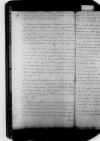Letter #5768
Alfonso de VALDÉS to Ioannes DANTISCUS[Regensburg], [ca. 1532-04-16?]
English register:
Valdés asks Dantiscus to send him his portrait if it is ready, because master Granvelle wants to see it in order to decide whether to commission his own portrait from the same painter. Valdés is returning the historical work (historicum tuum Sycophantam) after reading it and asks to have back Juan Ginés de Sepúlveda’s little book because he wants to enclose it in a letter to Erasmus.
Manuscript sources:
Auxiliary sources:
Prints:
| ||||||||||||||||||||
Text & apparatus & commentaryPlain textText & commentaryText & apparatus
Salutem.
Dominus
ms 1 2 Gniesii⌈
ms 1 2 Gniesii⌉ libellum[1] ad me mittito, ut eum litteris[2] meis ad
Vale.
print 1 Tuus Valdesius,
ms 1 2 omitted⌈Tuus
ms 1 2 omitted⌉


 BK 222, No. 54, p. 198
BK 222, No. 54, p. 198